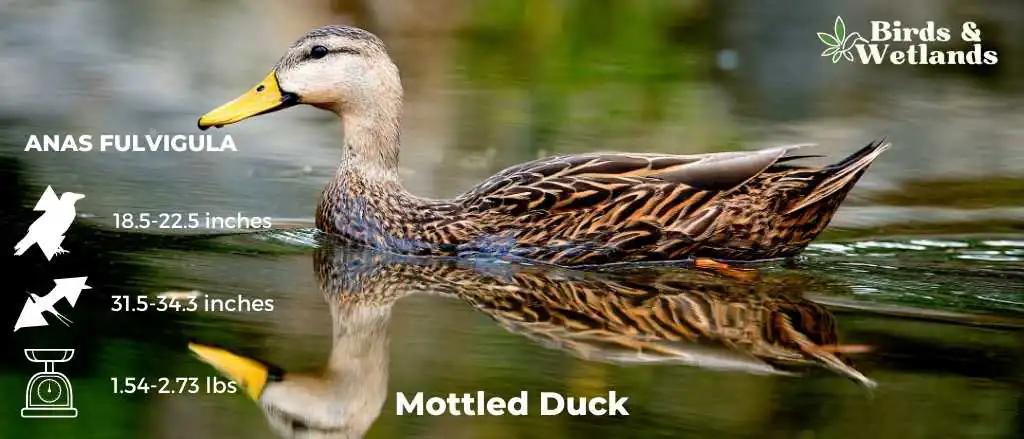The mottled duck (Anas fulvigula) is a medium-sized dabbling duck native to the Gulf Coast from Florida to Texas.
It inhabits shallow brackish wetlands, coastal marshes, and estuaries, feeding on various small animals such as crustaceans, mollusks and aquatic insects.
Its plumage is mostly gray-brown with distinctive white spots, which gives them its common name, ‘mottled.’ It resembles a female mallard and an American black duck.
Scientific Name: Anas fulvigula
Height
- Male: 19.7–22.5 in (50–57 cm)
- Female: 18.5–21.0 in (47–53 cm)
Wingspan
- Male: 32.7–34.3 in (83–87 cm)
- Female: 31.5–327.2 in (80–831 cm)
Average Weight
- Male: 30.9–43.8 oz (880–1,240 g)
- Female: 24.7–40.6 oz (700–1,150 g)
Subspecies
The mottled duck has two subspecies:
- Gulf Coast mottled duck (A. f. maculosa) – lives along the western Gulf Coast
- Florida mottled duck (A. f. fulvigula) – also known as the Florida duck or Florida mallard. Lives in central and southern Florida. A few Florida mottled ducks live in Georgia and South Carolina.
Physical Description
The adult mottled duck has a long, dark body with lighter underparts. The drake has an olive green to the bright yellow bill, and the female has a deep to pale orange bill with or without dark markings. Male mottled ducks are slightly larger than females.
Both sexes have dark eyes and a shiny green-blue wing speculum that lacks a white border, and the wingspan is smaller. In flight, the unique wing patch sets it apart from other ducks.
It appears slightly lighter than the American black duck, and its wing patch is more blue than purple.
All the species in the “mallard complex” share similar body shapes and sizes.
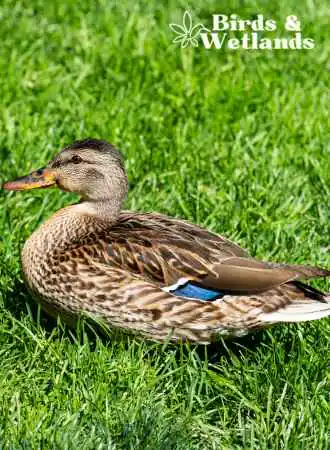
Listen to the Mottled Duck
The female calls sound like the quack of the female mallard.
Habitat & Range
The mottled duck is a non-migratory species and has a limited range. It is found in the southern United States, particularly in coastal areas. It normally stays within its range all year, but some ducks may travel short distances in search of better food sources.
The mottled duck is found in various wetland habitats, including lakes, marshes, swamps and flooded fields such as rice fields. It prefers shallow water bodies with plenty of vegetation, where it can feed on aquatic plants and small invertebrates.
The mottled duck is also commonly found in agricultural areas, where it feeds on seeds and other plant material.
The breeding range of the mottled duck is largely confined to the southern United States, from Texas to Florida. However, it also occurs in northern Mexico and Central America.
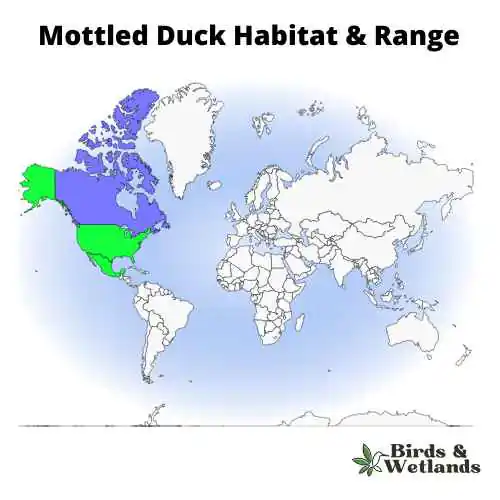
Feeding Habits & Diet
As a species, mottled ducks are omnivorous, which means they consume a wide variety of plant and animal matter.
Like most dabbling ducks, these birds are opportunistic feeders and will eat whatever food is most readily available to them in their environment. Depending on the season and food availability, they may switch between different foraging strategies.
In general, mottled ducks feed on various plants, including the seeds and shoots of many grasses. They also supplement their diet with small animals such as insects, mollusks, aquatic invertebrates, and occasionally small fish.
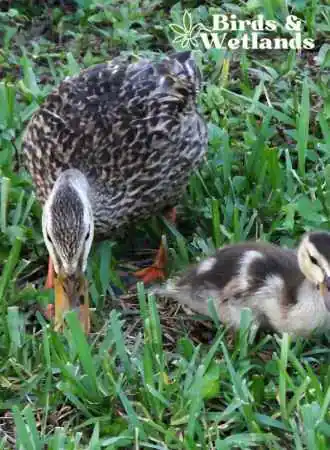
Nesting & Mating Habits
The breeding season for mottled ducks typically begins in early spring, when the males compete for the females’ attention. During this time, the males will engage in elaborate courtship displays, including vocalizations and elaborate feather displays, to attract a mate.
Once a hen has been attracted, the pair will find a suitable nesting site. Mottled ducks prefer to nest in areas with plenty of vegetation for cover, such as in the southern marshes and swamps.
The female mottled duck will build a nest out of plant material, often using cattails, marsh grass, reeds, bull-rush and other wetland plants to create a platform for her eggs.
The average clutch size for mottled ducks is 8 to 12 greenish-white eggs, which the hen will incubate for an average of 25 to 27 days.
Once the eggs have hatched, the hen will lead her ducklings to the nearest body of water, where they will learn how to forage for food and fend for themselves. The ducklings will remain with their mother for several months until they are old enough to fend for themselves.
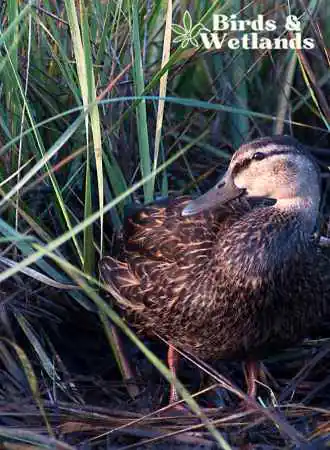
Threats & Conservation
Although mottled ducks are not endangered or threatened at this point, their conservation status is still causing concern.
The main threat to their survival is habitat loss due to human activities such as urbanization and development. Other threats include illegal hunting, pollution from oil spills, and competition from non-native species.
Additionally, the mottled duck population is experiencing a slow decline due to a relatively low reproductive success rate compared to other waterfowl. Also, because they prefer freshwater wetlands with dense vegetation and mudflats, they require substantial wetland protection efforts.
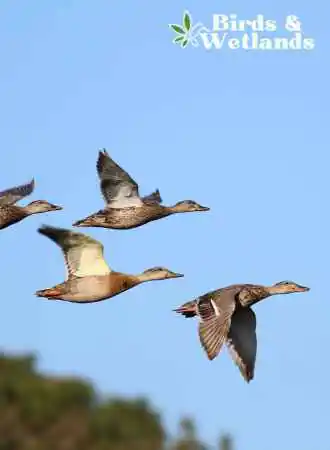
Hunting
In the United States, hunting mottled ducks is permitted in certain areas under strict regulations. Hunting season varies depending on location and state laws but is typically open from mid-September through late December or early January.
Hunters must obtain the necessary hunting license and permits before they may hunt and ensure that they understand the local regulations they must follow when seeking mottled ducks.
Key Points
- Male and female mottled ducks look similar to female mallards.
- Mottled ducks are closely related to Mexican ducks, mallards and American black ducks.
- The bill color distinguish the drake from the hen.
- These birds eat plants and small animals.

